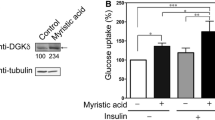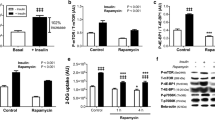Abstract
Lysophosphatidic acid (LPA) is known to have diverse cellular effects, but although LPA is present in many biological fluids, including blood, its effects on glucose metabolism have not been elucidated. In this study, we investigated whether LPA stimulation is related to glucose regulation. LPA was found to enhance glucose uptake in a dose-dependent manner both in L6 GLUT4myc myotubes and 3T3-L1 adipocytes by triggering GLUT4 translocation to the plasma membrane. Moreover, the effect of LPA on glucose uptake was completely inhibited by pretreating both cells with LPA receptor antagonist Ki16425 and Gi inhibitor pertussis toxin. In addition, LPA increased the phosphorylation of AKT-1 with no effects on IRS-1, and LPA-induced glucose uptake was abrogated by pretreatment with the PI 3-kinase inhibitor LY294002. When low concentration of insulin and LPA were treated simultaneously, an additive effect on glucose uptake was observed in both cell types. In line with its cellular functions, LPA significantly lowered blood glucose levels in normal mice but did not affect insulin secretion. LPA also had a glucose-lowering effect in streptozotocin-treated type 1 diabetic mice. In combination, these results suggest that LPA is involved in the regulation of glucose homeostasis in muscle and adipose tissues.






Similar content being viewed by others
Abbreviations
- LPA:
-
lysophosphatidic acid
- LPC:
-
lysophosphatidylcholine
- STZ:
-
streptozotocin
- PTX:
-
pertussis toxin
- IRS:
-
insulin receptor substrate
References
Rajala MW, Scherer PE (2003) Minireview: the adipocyte—at the crossroads of energy homeostasis, inflammation, and atherosclerosis. Endocrinology 144:3765–3773
Bourey RE, Koranyi L, James DE, Mueckler M, Permutt MA (1990) Effects of altered glucose homeostasis on glucose transporter expression in skeletal muscle of the rat. J Clin Invest 86:542–547
Moller DE (2001) New drug targets for type 2 diabetes and the metabolic syndrome. Nature 414:821–827
Hutchinson DS, Bengtsson T (2005) Alpha1A-adrenoceptors activate glucose uptake in L6 muscle cells through a phospholipase C-, phosphatidylinositol-3 kinase-, and atypical protein kinase C-dependent pathway. Endocrinology 146:901–912
Perrini S, Natalicchio A, Laviola L, Belsanti G, Montrone C, Cignarelli A, Minielli V, Grano M, De Pergola G, Giorgino R, Giorgino F (2004) Dehydroepiandrosterone stimulates glucose uptake in human and murine adipocytes by inducing GLUT1 and GLUT4 translocation to the plasma membrane. Diabetes 53:41–52
Elmendorf JS (2002) Signals that regulate GLUT4 translocation. J Membr Biol 190:167–174
Wu-Wong JR, Berg CE, Wang J, Chiou WJ, Fissel B (1999) Endothelin stimulates glucose uptake and GLUT4 translocation via activation of endothelin ETA receptor in 3T3-L1 adipocytes. J Biol Chem 274:8103–8110
Kishi K, Muromoto N, Nakaya Y, Miyata I, Hagi A, Hayashi H, Ebina Y (1998) Bradykinin directly triggers GLUT4 translocation via an insulin-independent pathway. Diabetes 47:550–558
Tigyi G, Miledi R (1992) Lysophosphatidates bound to serum albumin activate membrane currents in Xenopus oocytes and neurite retraction in PC12 pheochromocytoma cells. J Biol Chem 267:21360–21367
Goetzl EJ, An S (1998) Diversity of cellular receptors and functions for the lysophospholipid growth factors lysophosphatidic acid and sphingosine 1-phosphate. FASEB J 12:1589–1598
Sengupta S, Wang Z, Tipps R, Xu Y (2004) Biology of LPA in health and disease. Semin Cell Dev Biol 15:503–512
Luquain C, Sciorra VA, Morris AJ (2003) Lysophosphatidic acid signaling: how a small lipid does big things. Trends Biochem Sci 28:377–383
Aoki J, Taira A, Takanezawa Y, Kishi Y, Hama K, Kishimoto T, Mizuno K, Saku K, Taguchi R, Arai H (2002) Serum lysophosphatidic acid is produced through diverse phospholipase pathways. J Biol Chem 277:48737–48744
Valet P, Pages C, Jeanneton O, Daviaud D, Barbe P, Record M, Saulnier-Blache JS, Lafontan M (1998) Alpha2-adrenergic receptor-mediated release of lysophosphatidic acid by adipocytes. A paracrine signal for preadipocyte growth. J Clin Invest 101:1431–1438
Ferry G, Tellier E, Try A, Gres S, Naime I, Simon MF, Rodriguez M, Boucher J, Tack I, Gesta S, Chomarat P, Dieu M, Raes M, Galizzi JP, Valet P, Boutin JA, Saulnier-Blache JS (2003) Autotaxin is released from adipocytes, catalyzes lysophosphatidic acid synthesis, and activates preadipocyte proliferation. Up-regulated expression with adipocyte differentiation and obesity. J Biol Chem 278:18162–18169
Simon MF, Daviaud D, Pradere JP, Gres S, Guigne C, Wabitsch M, Chun J, Valet P, Saulnier-Blache JS (2005) Lysophosphatidic acid inhibits adipocyte differentiation via lysophosphatidic acid 1 receptor-dependent down-regulation of peroxisome proliferator-activated receptor gamma2. J Biol Chem 280:14656–14662
Contos JJ, Fukushima N, Weiner JA, Kaushal D, Chun J (2000) Requirement for the lpA1 lysophosphatidic acid receptor gene in normal suckling behavior. Proc Natl Acad Sci U S A 97:13384–13389
Van den Berghe N, Ouwens DM, Maassen JA, van Mackelenbergh MG, Sips HC, Krans HM (1994) Activation of the Ras/mitogen-activated protein kinase signaling pathway alone is not sufficient to induce glucose uptake in 3T3-L1 adipocytes. Mol Cell Biol 14:2372–2377
Wang Q, Khayat Z, Kishi K, Ebina Y, Klip A (1998) GLUT4 translocation by insulin in intact muscle cells: detection by a fast and quantitative assay. FEBS Lett 427:193–197
Wijesekara N, Tung A, Thong F, Klip A (2006) Muscle cell depolarization induces a gain in surface GLUT4 via reduced endocytosis independently of AMPK. Am J Physiol Endocrinol Metab 290:E1276–1286
Lee S, Kim JH, Lee CS, Kim JH, Kim Y, Heo K, Ihara Y, Goshima Y, Suh PG, Ryu SH (2002) Collapsin response mediator protein-2 inhibits neuronal phospholipase D(2) activity by direct interaction. J Biol Chem 277:6542–6549
Spiegel S, Milstien S (1995) Sphingolipid metabolites: members of a new class of lipid second messengers. J Membr Biol 146:225–237
Xu Y (2002) Sphingosylphosphorylcholine and lysophosphatidylcholine: G protein-coupled receptors and receptor-mediated signal transduction. Biochim Biophys Acta 1582:81–88
Contos JJ, Ishii I, Chun J (2000) Lysophosphatidic acid receptors. Mol Pharmacol 58:1188–1196
507–534
Noguchi K, Ishii S, Shimizu T (2003) Identification of p2y9/GPR23 as a novel G protein-coupled receptor for lysophosphatidic acid, structurally distant from the Edg family. J Biol Chem 278:25600–25606
Ishii I, Fukushima N, Ye X, Chun J (2004) Lysophospholipid receptors: signaling and biology. Annu Rev Biochem 73:321–354
An S, Bleu T, Hallmark OG, Goetzl EJ (1998) Characterization of a novel subtype of human G protein-coupled receptor for lysophosphatidic acid. J Biol Chem 273:7906–7910
Im DS, Heise CE, Harding MA, George SR, O’Dowd BF, Theodorescu D, Lynch KR (2000) Molecular cloning and characterization of a lysophosphatidic acid receptor, Edg-7, expressed in prostate. Mol Pharmacol 57:753–759
Yanagida K, Ishii S, Hamano F, Noguchi K, Shimizu T (2007) LPA4/p2y9/GPR23 mediates Rho-dependent morphological changes in a rat neuronal cell line. J Biol Chem 282:5814–5824
Ohta H, Sato K, Murata N, Damirin A, Malchinkhuu E, Kon J, Kimura T, Tobo M, Yamazaki Y, Watanabe T, Yagi M, Sato M, Suzuki R, Murooka H, Sakai T, Nishitoba T, Im DS, Nochi H, Tamoto K, Tomura H, Okajima F (2003) Ki16425, a subtype-selective antagonist for EDG-family lysophosphatidic acid receptors. Mol Pharmacol 64:994–1005
Saltiel AR, Kahn CR (2001) Insulin signalling and the regulation of glucose and lipid metabolism. Nature 414:799–806
Richter EA, Derave W, Wojtaszewski JF (2001) Glucose, exercise and insulin: emerging concepts. J Physiol 535:313–322
Astrup A, Finer N (2000) Redefining type 2 diabetes: ‘diabesity’ or ‘obesity dependent diabetes mellitus’? Obes Rev 1:57–59
Despres JP, Lemieux I (2006) Abdominal obesity and metabolic syndrome. Nature 444:881–887
Acknowledgements
This work was supported by the 21C Frontier Functional Proteomics Project of the Korean Ministry of Science and Technology. We are grateful to Dr. Amira Klip (Hospital for Sick Children, Toronto, Ontario, Canada) for kindly providing the L6 GLUT4myc myoblasts.
Author information
Authors and Affiliations
Corresponding author
Rights and permissions
About this article
Cite this article
Yea, K., Kim, J., Lim, S. et al. Lysophosphatidic acid regulates blood glucose by stimulating myotube and adipocyte glucose uptake. J Mol Med 86, 211–220 (2008). https://doi.org/10.1007/s00109-007-0269-z
Received:
Revised:
Accepted:
Published:
Issue Date:
DOI: https://doi.org/10.1007/s00109-007-0269-z




